

Most ebook files are in PDF format, so you can easily read them using various software such as Foxit Reader or directly on the Google Chrome browser.
Some ebook files are released by publishers in other formats such as .awz, .mobi, .epub, .fb2, etc. You may need to install specific software to read these formats on mobile/PC, such as Calibre.
Please read the tutorial at this link: https://ebookbell.com/faq
We offer FREE conversion to the popular formats you request; however, this may take some time. Therefore, right after payment, please email us, and we will try to provide the service as quickly as possible.
For some exceptional file formats or broken links (if any), please refrain from opening any disputes. Instead, email us first, and we will try to assist within a maximum of 6 hours.
EbookBell Team

5.0
38 reviewsThe focused ion beam (FIB) instrument has experienced an intensive period of maturation since its inception. Numerous new techniques and applications have been brought to fruition, and over the past few years, the FIB has gained acceptance as more than just an expensive sample preparation tool. It has taken its place among the suite of other instruments commonly available in analytical and forensic laboratories, universities, geological, medical and biological research institutions, and manufacturing plants.
Although the utility of the FIB is not limited to the preparation of specimens for subsequent analysis by other analytical techniques, it has revolutionized the area of TEM specimen preparation. The FIB has also been used to prepare samples for numerous other analytical techniques, and offers a wide range of other capabilities. While the mainstream of FIB usage remains within the semiconductor industry, FIB usage has expanded to applications in metallurgy, ceramics, composites, polymers, geology, art, biology, pharmaceuticals, forensics, and other disciplines. Computer automated procedures have been configured for unattended use of FIB and dual platform instruments. New applications of FIB and dual platform instrumentation are constantly being developed for materials characterization and nanotechnology. The site specific nature of the FIB milling and deposition capabilities allows preparation and processing of materials in ways that are limited only by one's imagination.
Introduction to Focused Ion Beams
is geared towards techniques and applications. The first portion of this book introduces the basics of FIB instrumentation, milling, and deposition capabilities. The chapter dedicated to ion-solid interactions is presented so that the FIB user can understand which parameters will influence FIB milling behavior. The remainder of the book focuses on how to prepare and analyze samples using FIB and related tools, and presents specific applications and techniques of the uses of FIB milling, deposition, and dual platform techniques. This is the only text that discusses and presents the theory directly related to applications and the only one that discusses the vast applications and techniques used in FIBs and Dual platform instruments.